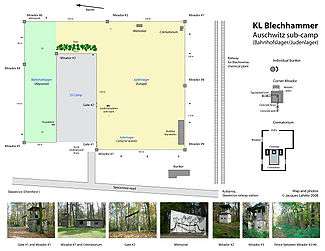Blechhammer
| Blechhammer | |
|---|---|
| Part of Provinz Schlesien of Greater Germany | |
| Located in Upper Silesia | |
|
Blechhammer map of Bahnhofslager/Judenlager | |
| Coordinates |
North plant 50°21′N 18°18′E / 50.350°N 18.300°E |
| Site history | |
| In use | 1942-1945 (50,000 POWs)[2] |
| Battles/wars | Oil Campaign of World War II |
| Events |
1944-05: flak guns added |
The Blechhammer (English: sheet metal hammer) area was the location of Nazi Germany chemical plants, prisoner of war (POW) camps, and forced labor camps (German: Arbeitslager Blechhammer; also Nummernbücher).[4] Labor camp prisoners began arriving as early as June 17, 1942,[5] and in July 1944, 400-500 men were transferred from the Terezin family camp to Blechhammer. The mobile “pocket furnace” (German: Taschenofen) crematorium was at Sławięcice.) and Bau und Arbeits Battalion (BAB, English: Construction Battalion) 21 was a mile from the Blechhammer oil plants and was not far from Kattowitz and Breslau.[6] Blechhammer synthetic oil production began April 1 with 4000 prisoners.
- Chemical plants
- Two plants in the area, Blechhammer North (south of Sławięcice) and Blechhammer South at Azoty (5 miles (8.0 km) from the labor camp)[5] were nicknamed "Black Hammer" by Allied bomber aircrews.[7] The facilities were approximately 2 miles (3.2 km) apart with each occupying a 3,000 x 5,000 ft area in open country.[8] Similar to the Gelsenberg plant, the Blechhammer plants used bituminous coal[1] in the Bergius process to synthesize Ersatz oil.[9] In June 1944, the United States Army Air Forces considered Blechhammer one of the four "principal synthetic oil plants in Germany",[10] and after the Fifteenth Air Force had dropped 7,082 tons of bombs on Blechhammer, the Blechhammer plants were dismantled post-war by the Soviets.[1]
- Evacuation
- The March (1945) evacuated POWs (one camp went to Regensburg,[11] BAB 21 went to Landshut)[6] and on January 25, labor camp prisoners were force-marched for five days to Bergen Belsen[5] (about 20% died en route).. Some small groups did manage to escape (see František R. Kraus).
The "7 Company" was the guard battalion for Blechhammer, and the 1945 Belsen Trial convicted Blechhammer staff members Karl Francioh and Ansgar Piche.
| Wikimedia Commons has media related to Labor camp Blechhammer. |
|
| |
|
| |
|
|
References
- 1 2 3 Stranges, Dr. Anthony. "Fischer-Tropsch Archive". Washington, D.C.: Fischer-Tropsch.org. Retrieved 2009-06-17.
- ----- (2003). "Germany's Synthetic Fuel Industry 1927-45" (pdf). Fischer-Tropsch.org. Retrieved 2009-10-20.
- "Synthetic Oil Production" (PDF). p. 160. Retrieved 2009-11-19.
- Schroeder, W. C. (August 1946). "Report On Investigations by Fuels and Lubricants Teams At The I.G. Farbenindustrie, A. G., Works, Ludwigshafen and Oppau". US Bureau of Mines, Office of Synthetic Liquid Fuels. Retrieved 2009-03-21.
- ↑ "Former PoWs Remember horror". Daily Mail. 4 May 2005. Retrieved 2009-04-21.
- ↑ Gregory, Mackenzie J. "Norman "Nobby" Hayes was on the Voltaire". Ahoy - Mac's Web Log. ahoy.tk-jk.net. Retrieved 2009-04-18.
- ↑ "Glossary of ITS terms and abbreviations" (PDF). Registry of Holocaust Survivors. United States Holocaust Memorial Museum.
- 1 2 3 Schwarzfitter, Jacob (August 28, 1946). "Voices (Jacob Schwarzfitter)". Interview Archive. Retrieved 2009-03-19.
- 1 2 Hutson, Fred (April 2006). "Fred Hutson". Tommy's Log: The Logbook of Tachus (Tommy) Constantine McNamee. MurrayArmstrong.com. Retrieved 2009-04-22.
- ↑ Withington, Ted (1993). Flight to Black Hammer: the letters of a World War II pilot. Biddle Publishing Company. ISBN 1-879418-06-1.
- ↑ "June 1944". 461st Bombardment Group Missions.
Mission #52
- ↑ Ludmer, Henry (March 28, 1946). "Oil in Germany" (pdf). No. 6, Vol. XLVII. University of Toledo. pp. 259–63. Retrieved 2009-02-11.
- ↑ Cruickshank, Earl (tbd--Air Force Historical Study (AFHS) No. 103) [1944--Army Air Forces Reference History (AAFRH)-3]. "The Ploesti Mission of 1 August 1943". p. 3. Retrieved 2009-05-09. Check date values in:
|date=(help) - 1 2 Jones, Chris (19 September 2004). "Message 1 - blechammer, el tahag and chieti". WW2 People's War - Dad's Journey. BBC.co.uk. Retrieved 2009-04-21.
the main one referred to as 'E3' in the Stalag labour system was to be found there, though the others in and around the area include: BAB 20, 21, 40 and 48; and E711, E711A, E769, E793 E794 (these last two were renamed BAB20 and 21)
- ↑ "Anlage zu § 1 Verzeichnis der Konzentrationslager und ihrer Außenkommandos gemäß § 42 Abs. 2 BEG" (in German). Bundesministerium der Justiz. Retrieved 2009-04-30.
- ↑ "The Wartime Memories Project - STALAG 8b (344) POW Camp". World War Two 1939-1945. WarTimeMemories.co.uk. Retrieved 2009-04-21.
External links
- Life at Blechhamer and the work parties is described in "Captive Plans", the POW diary of Reg Beattie: Published P.O.W. Diary of Reg Beattie
- http://www.obozy-blechhammer.eu - Polish website depicting Zwangsarbeitslager fur Juden in Blechhammer/Arbeitslager Blechhammer camp
